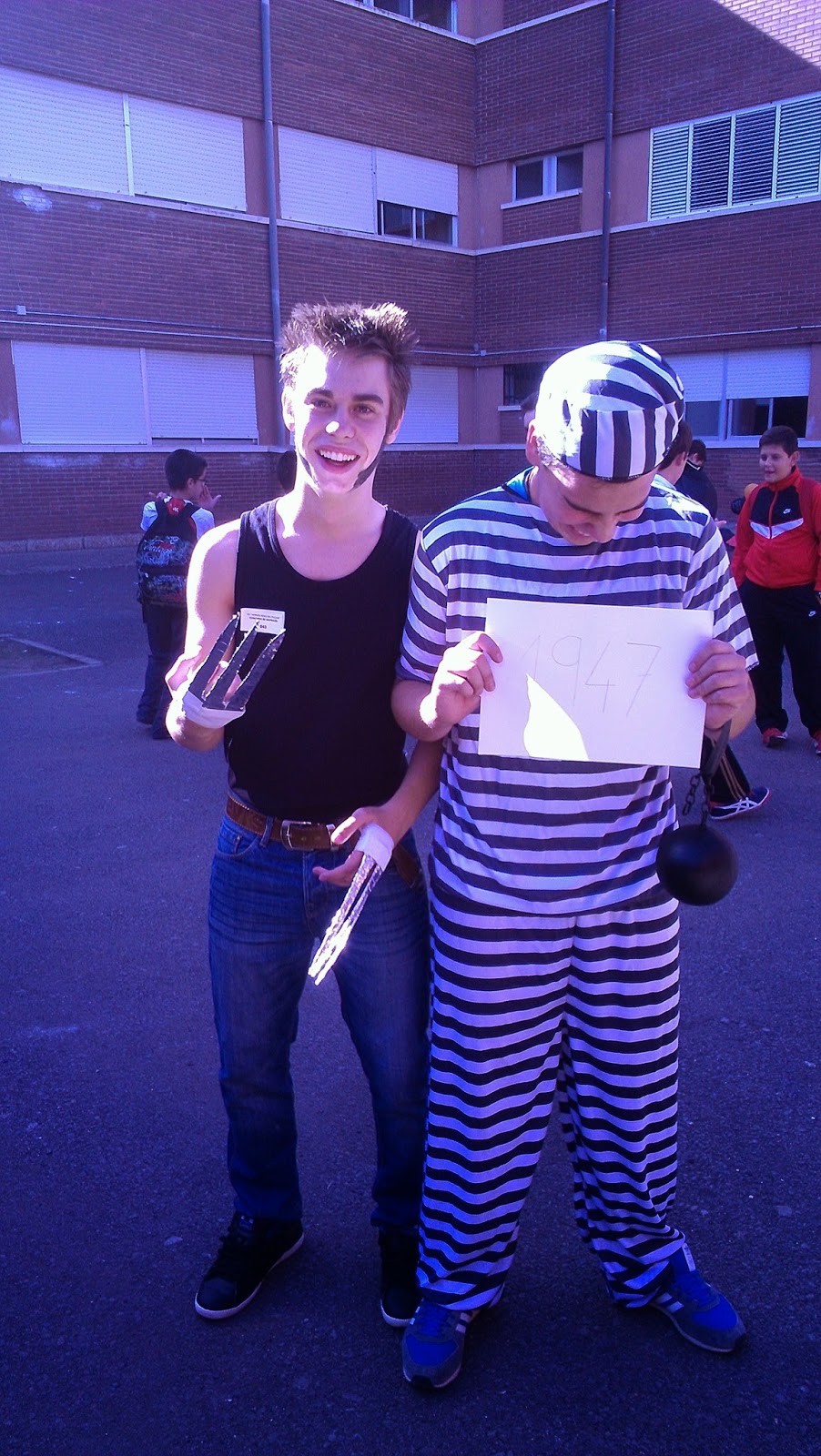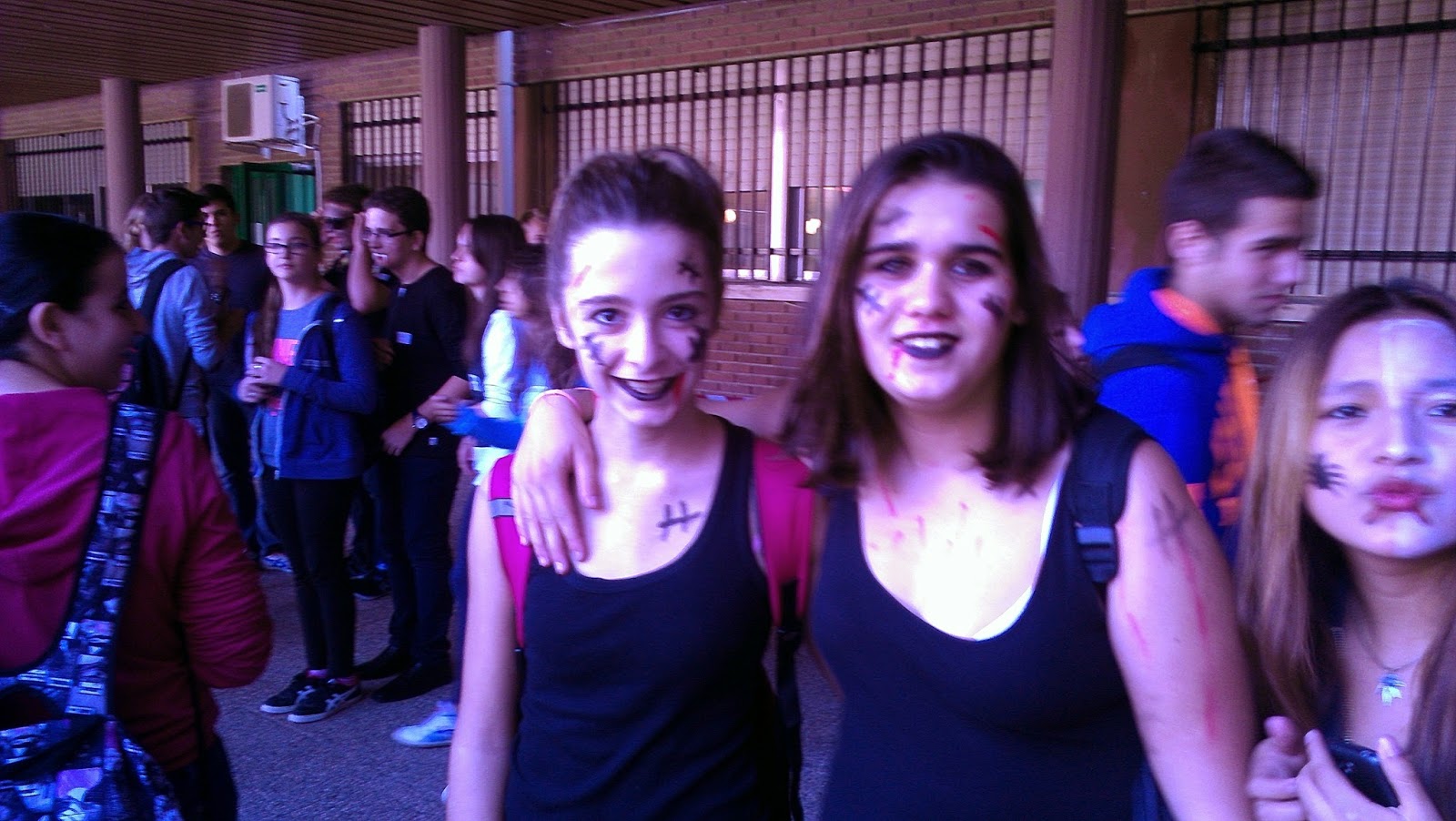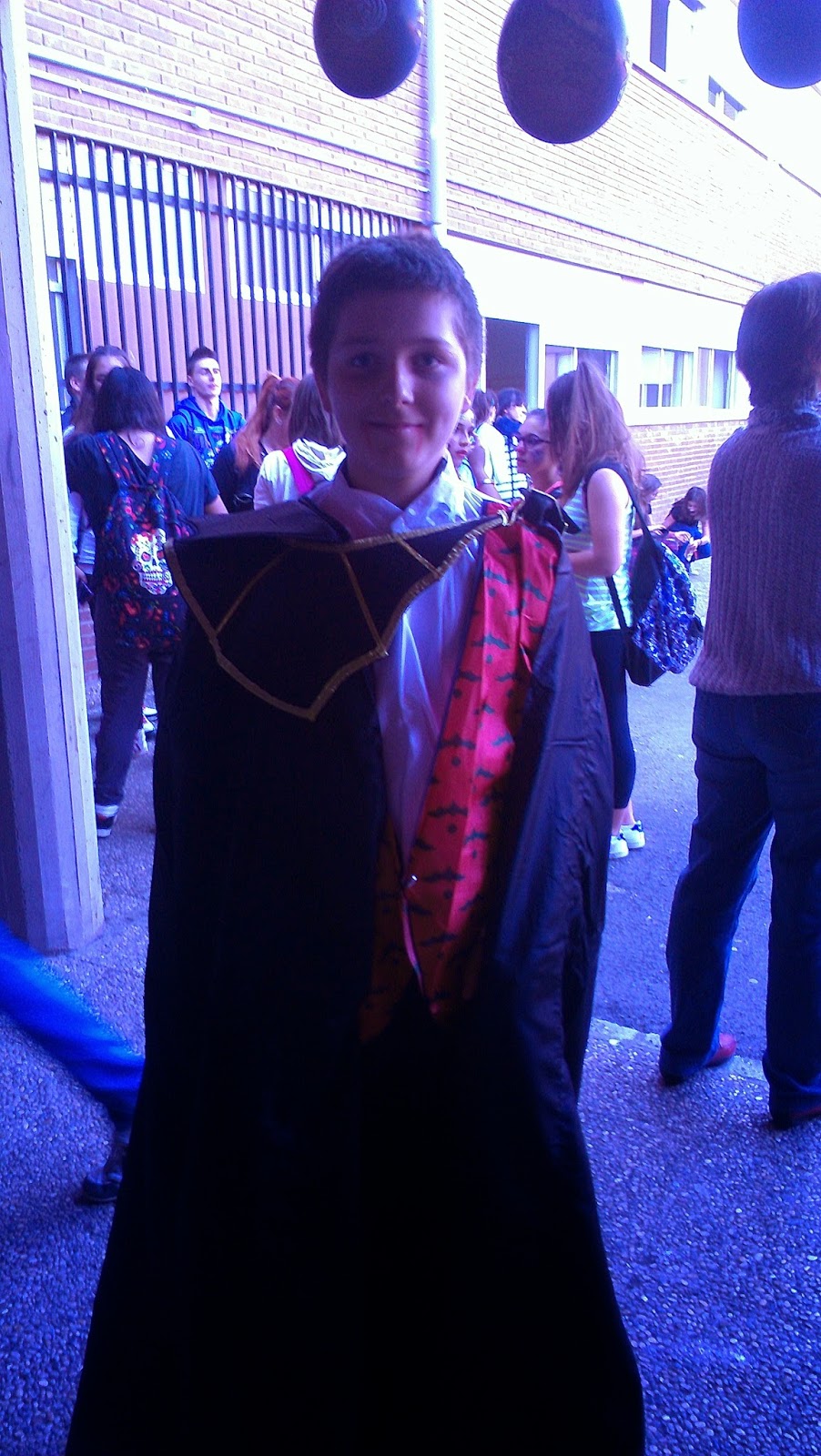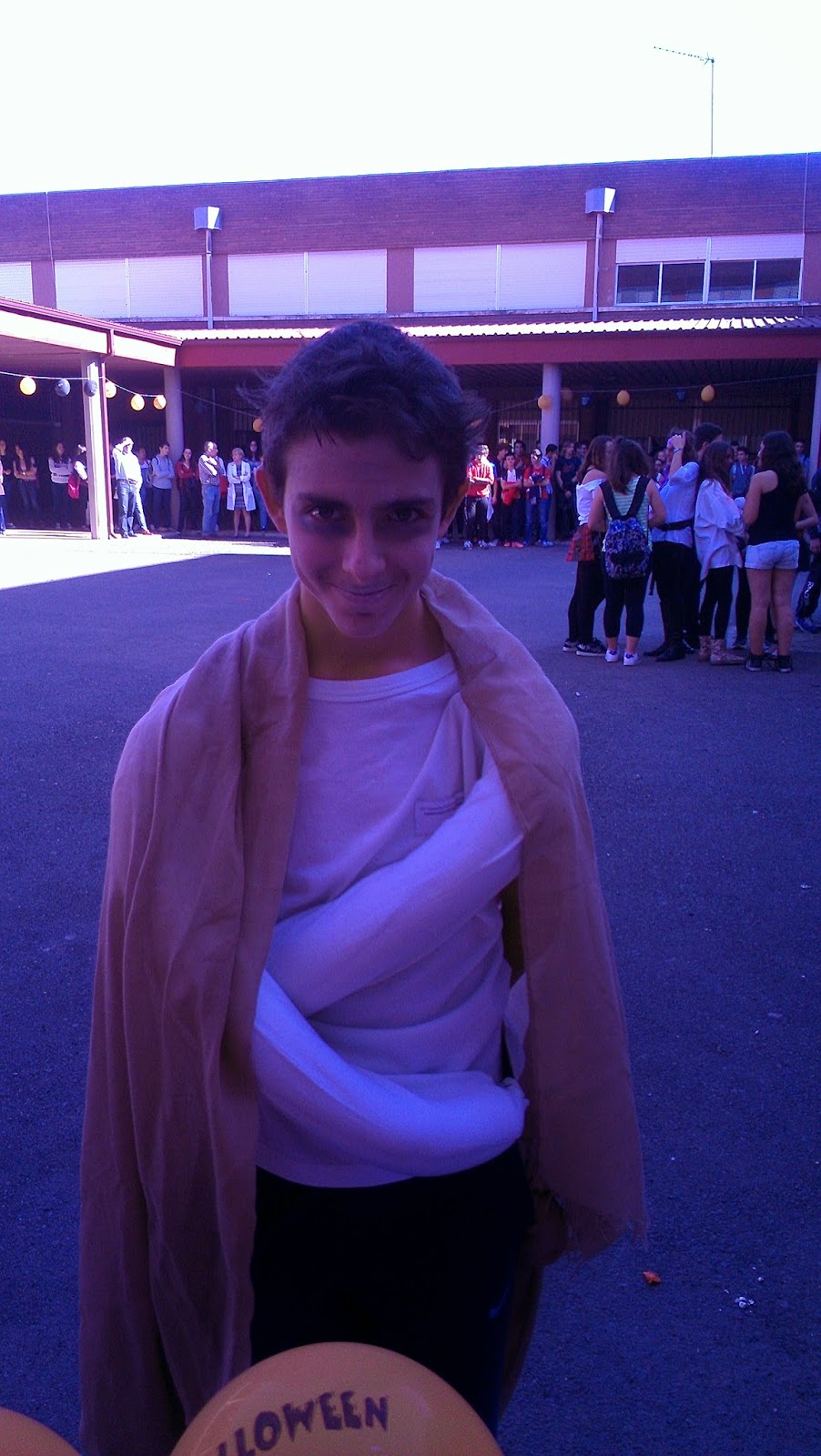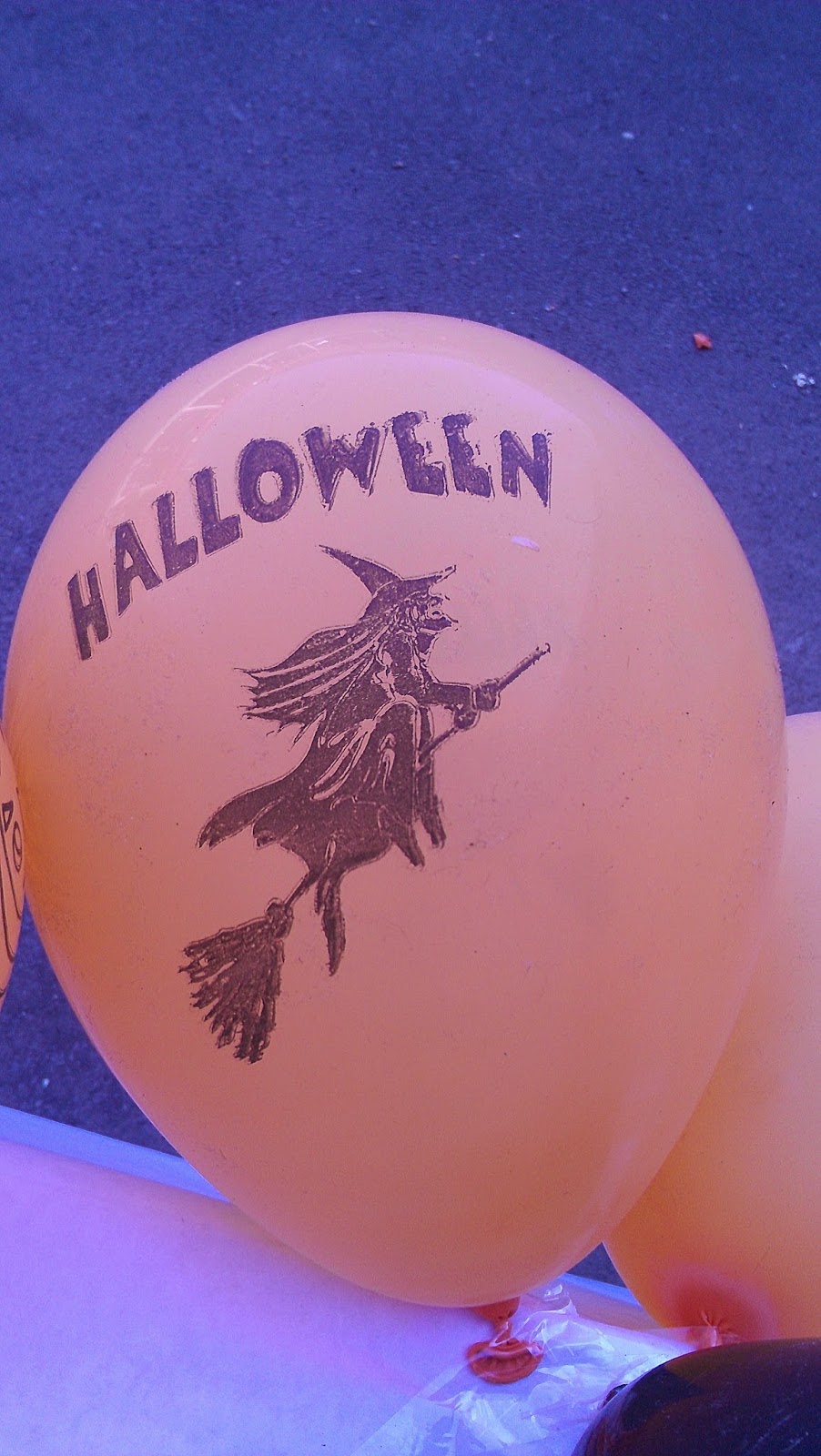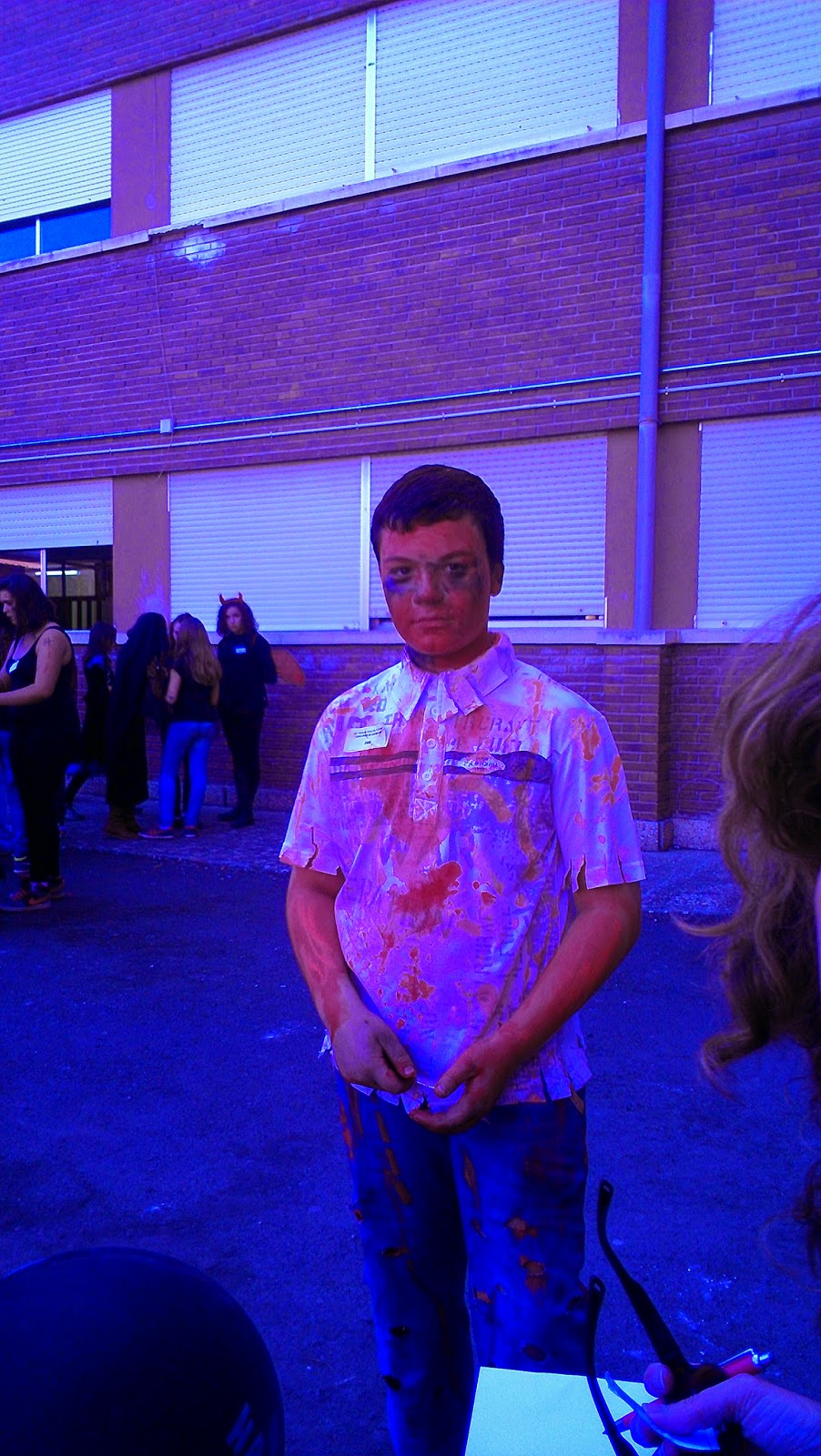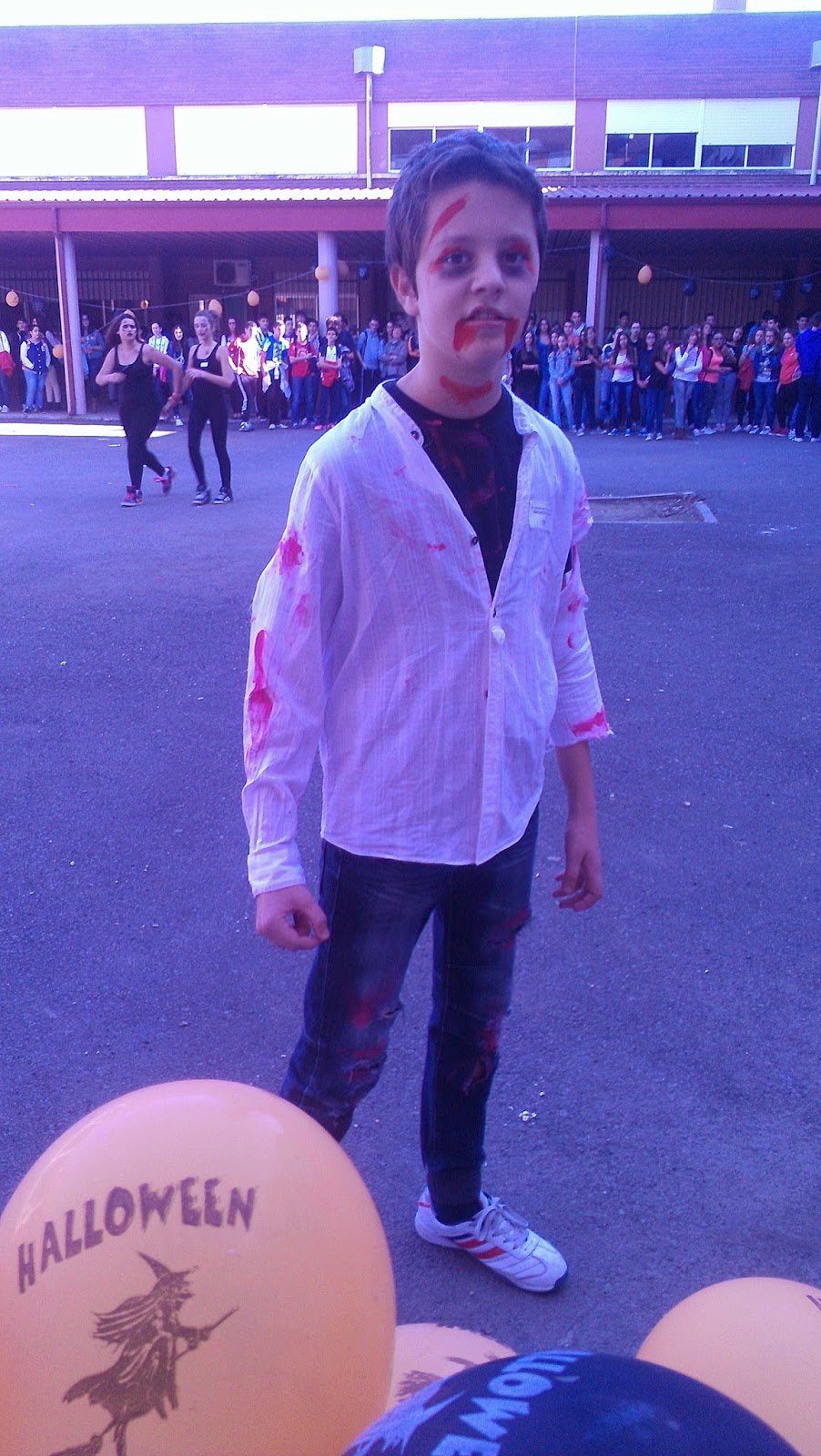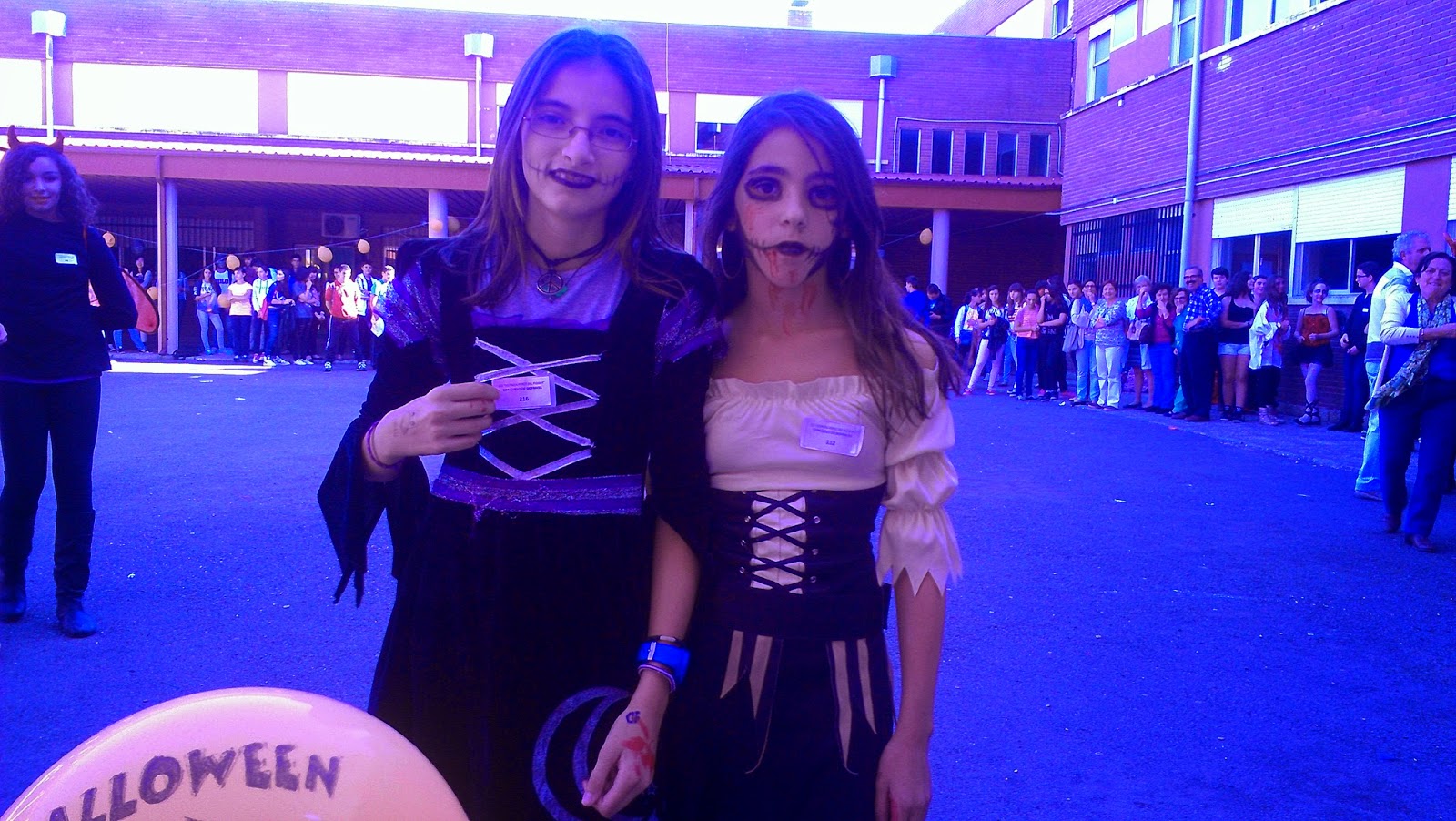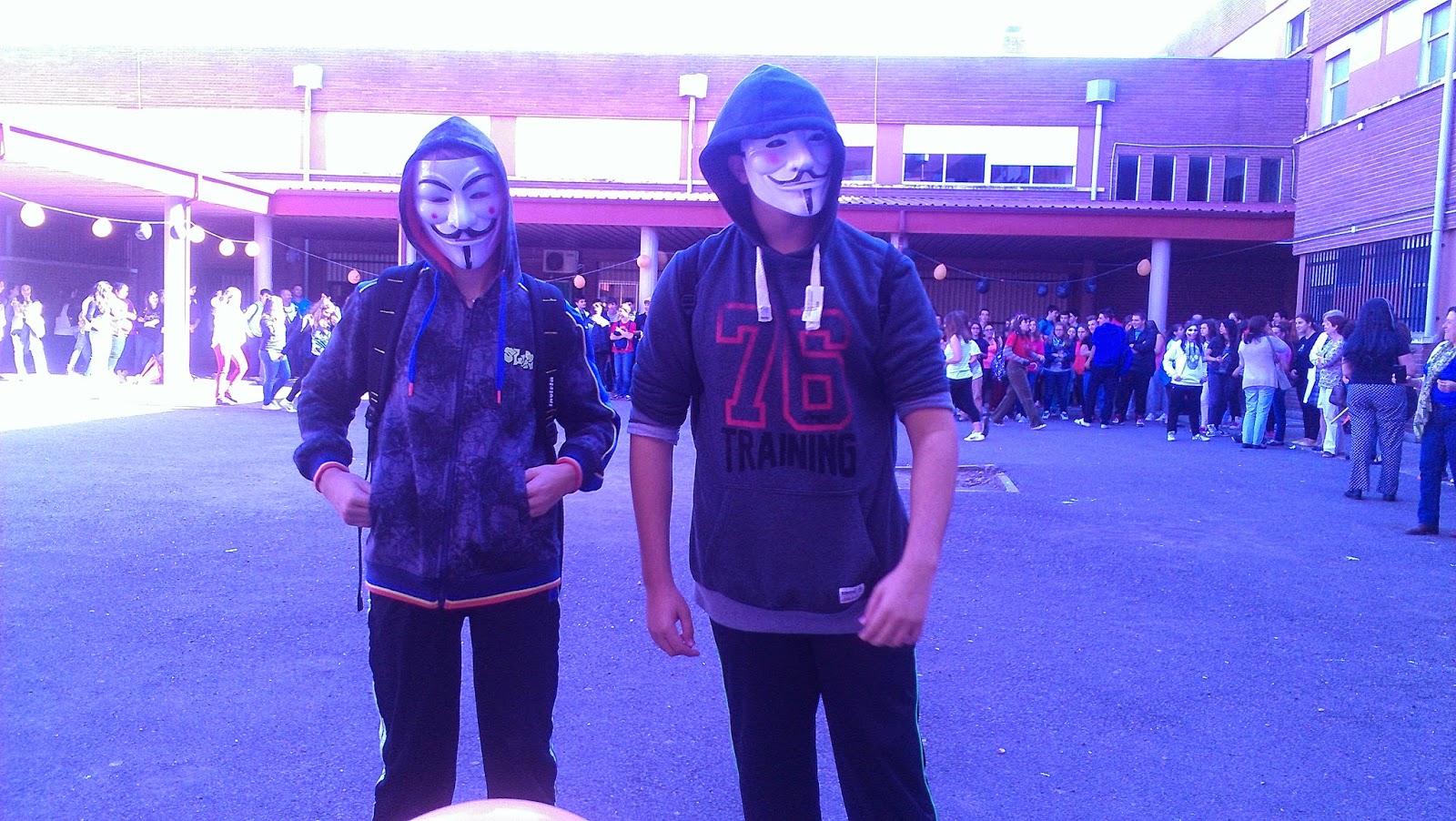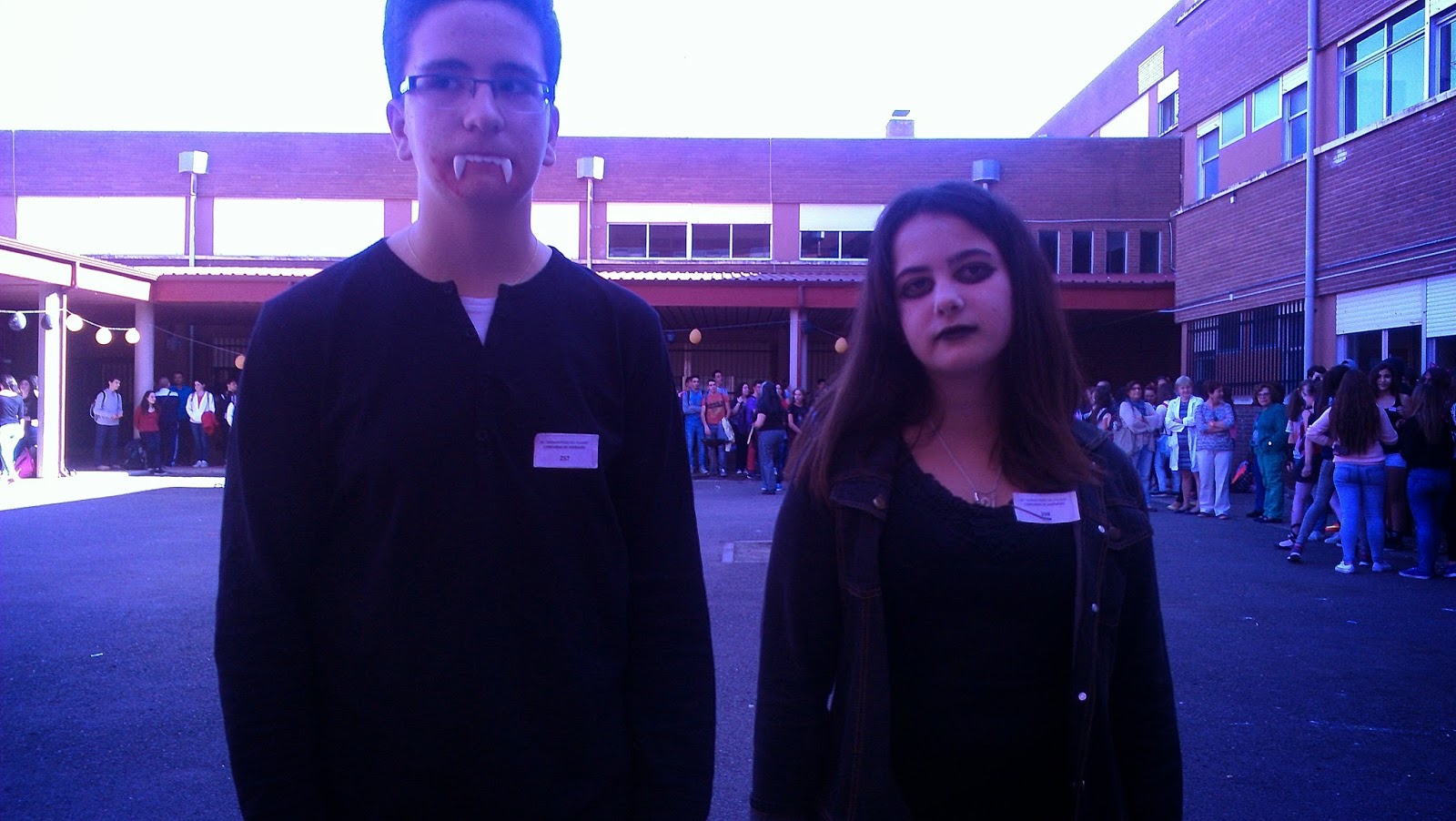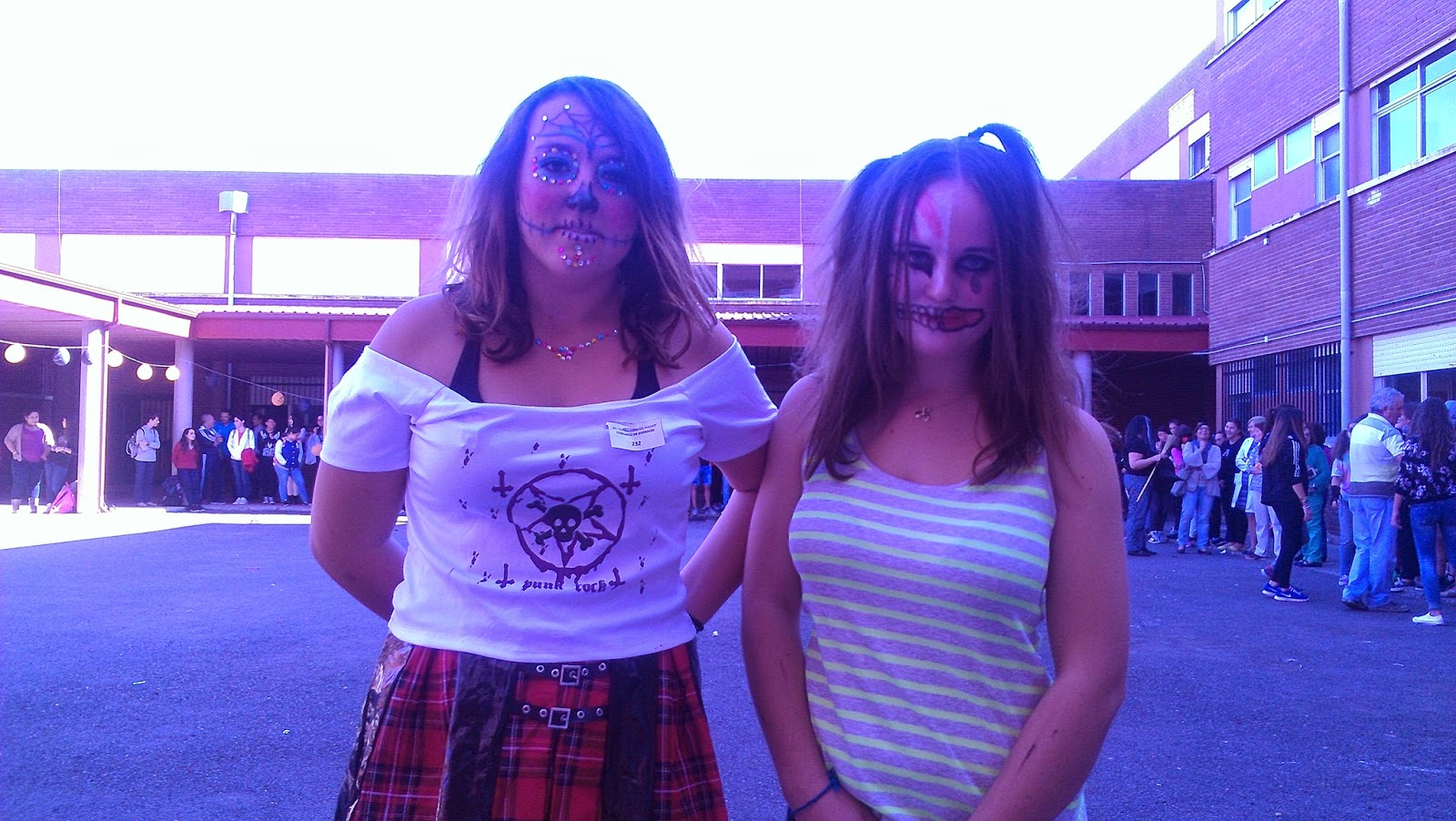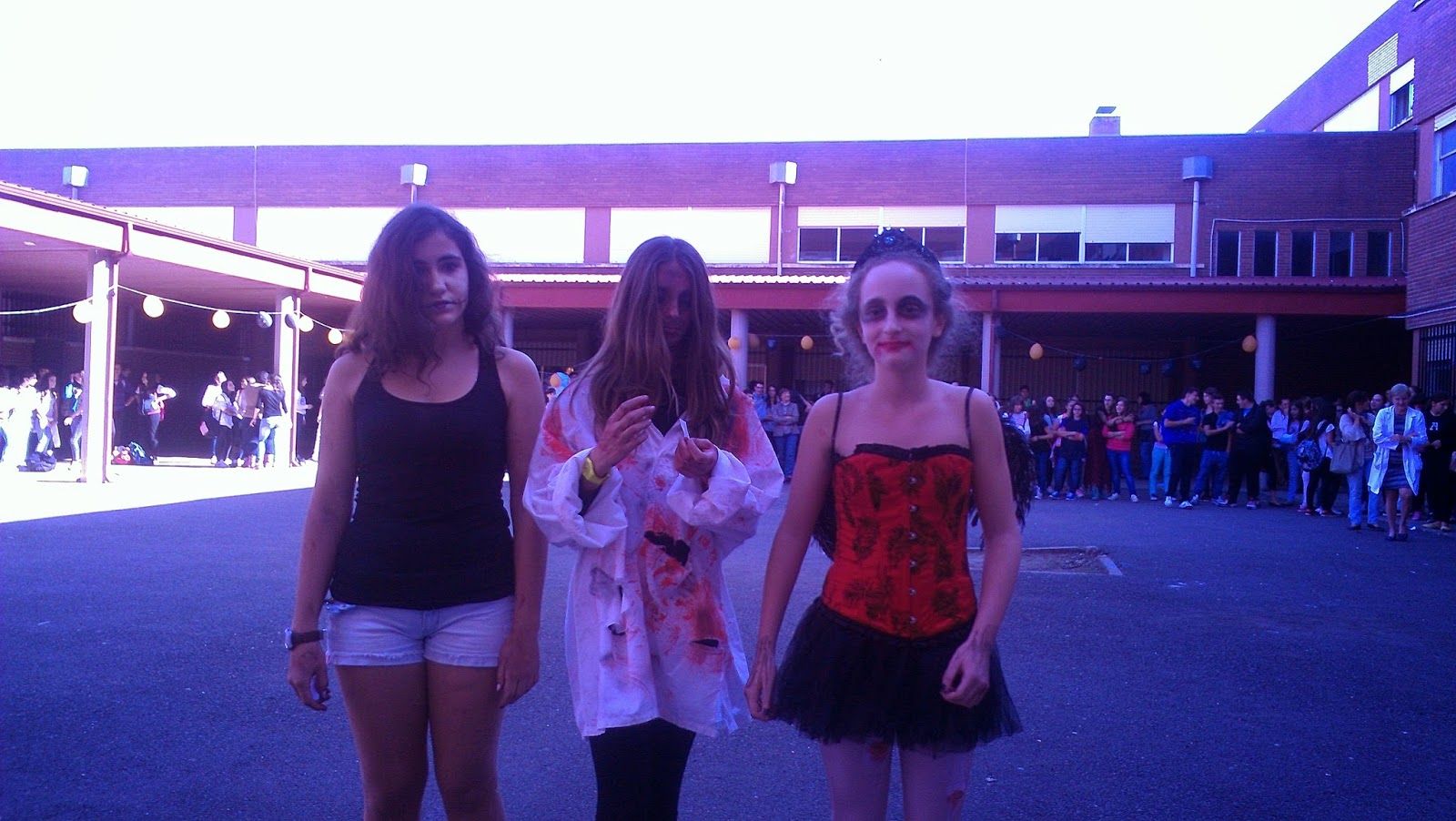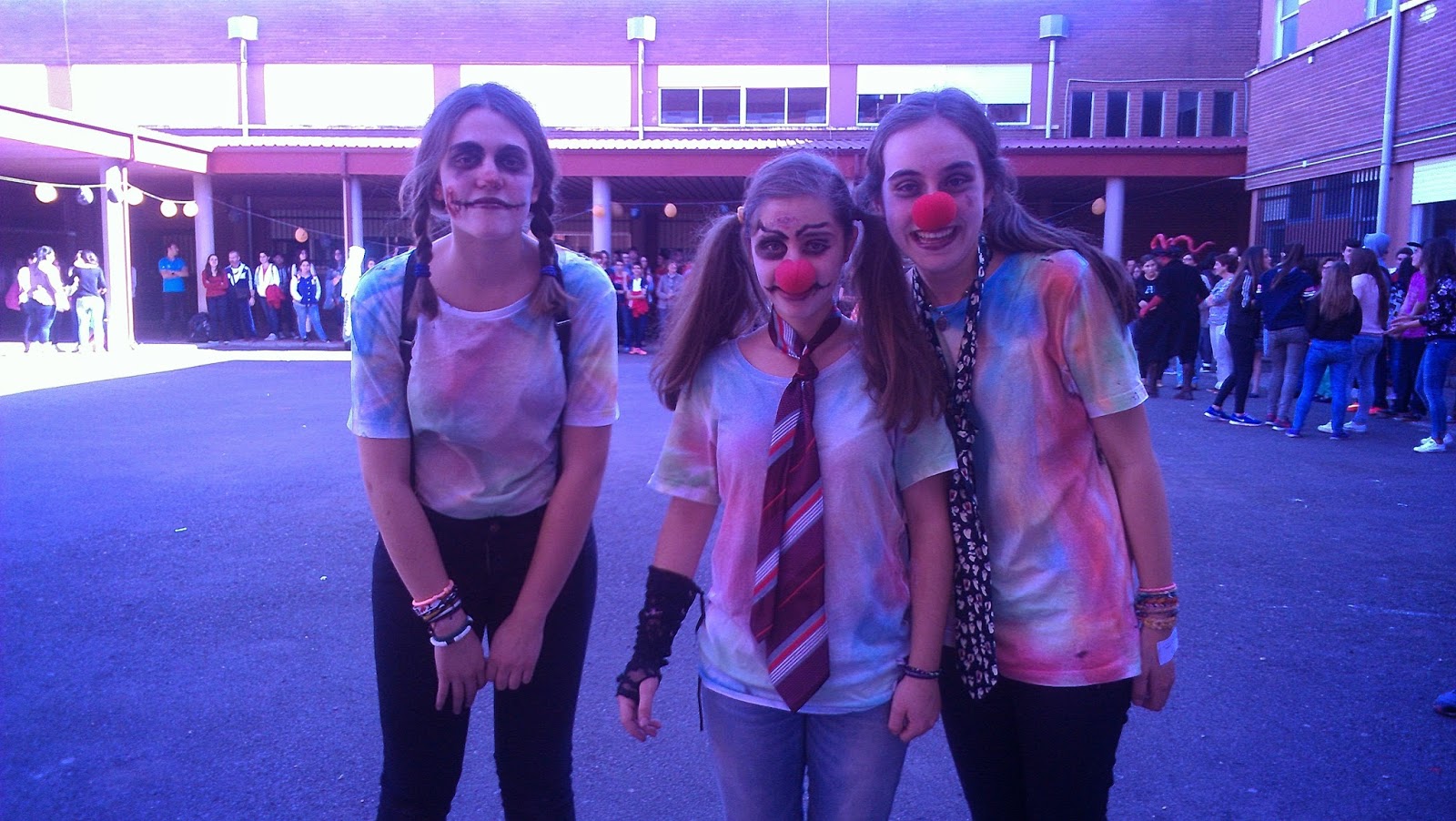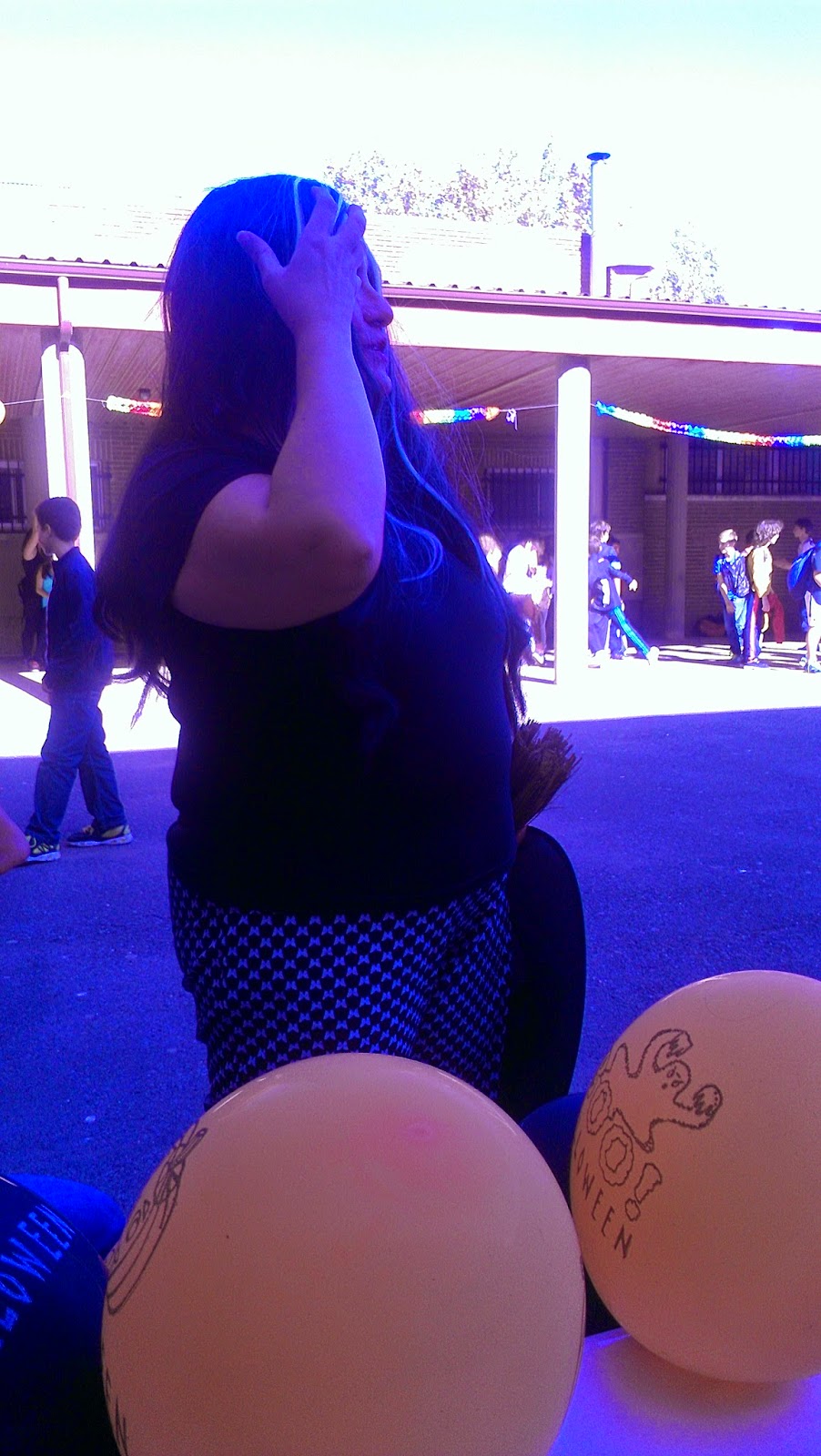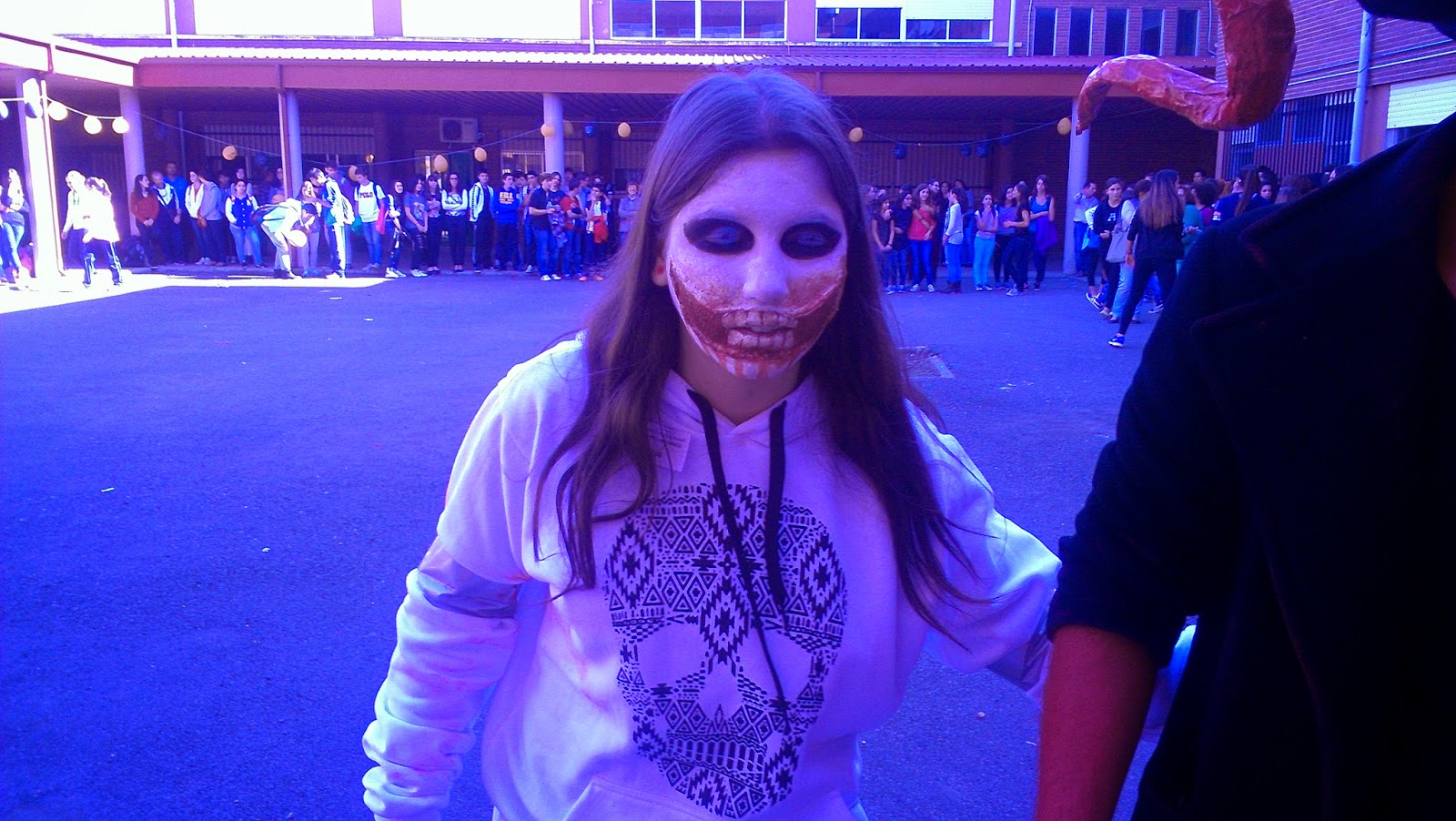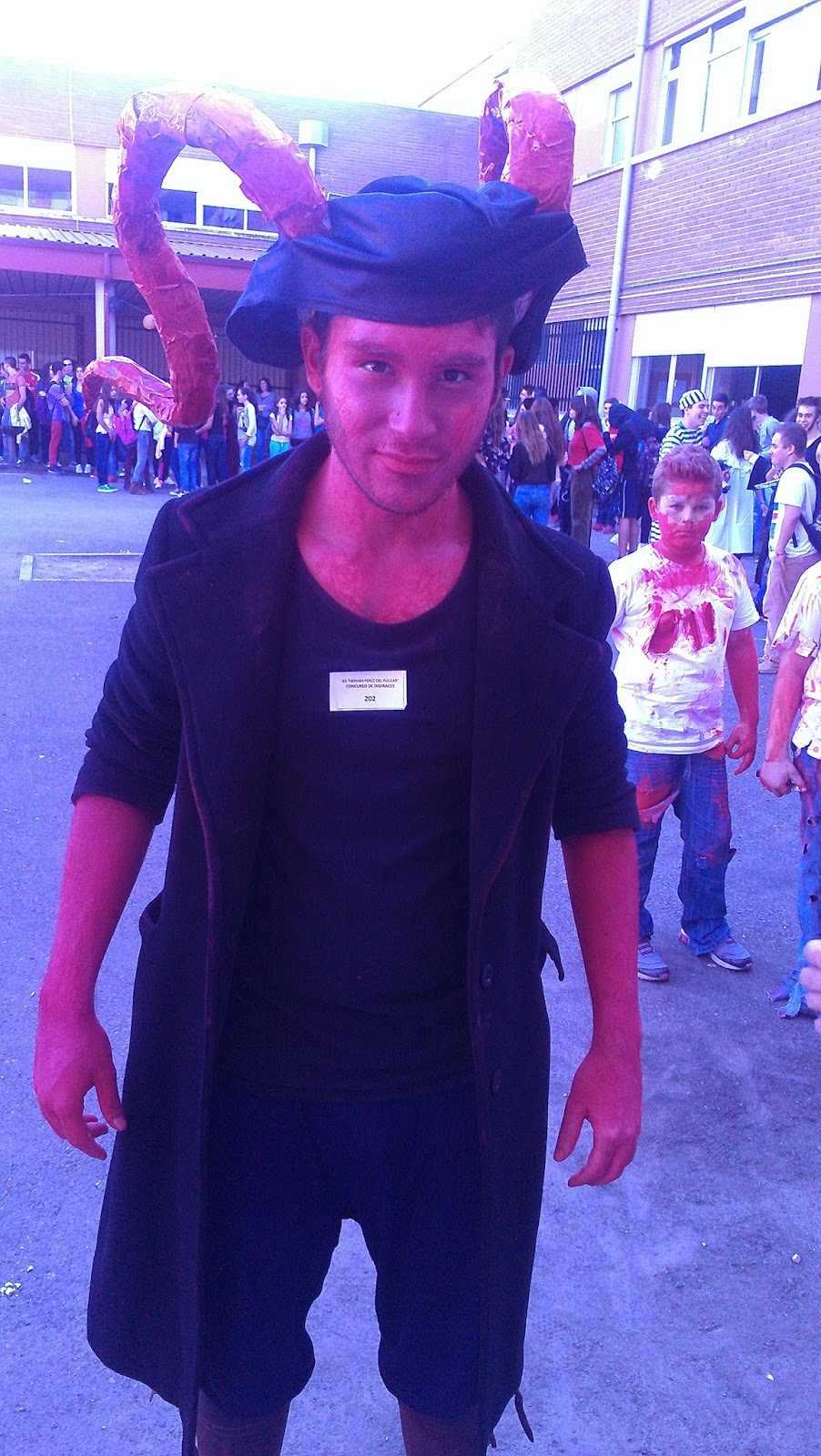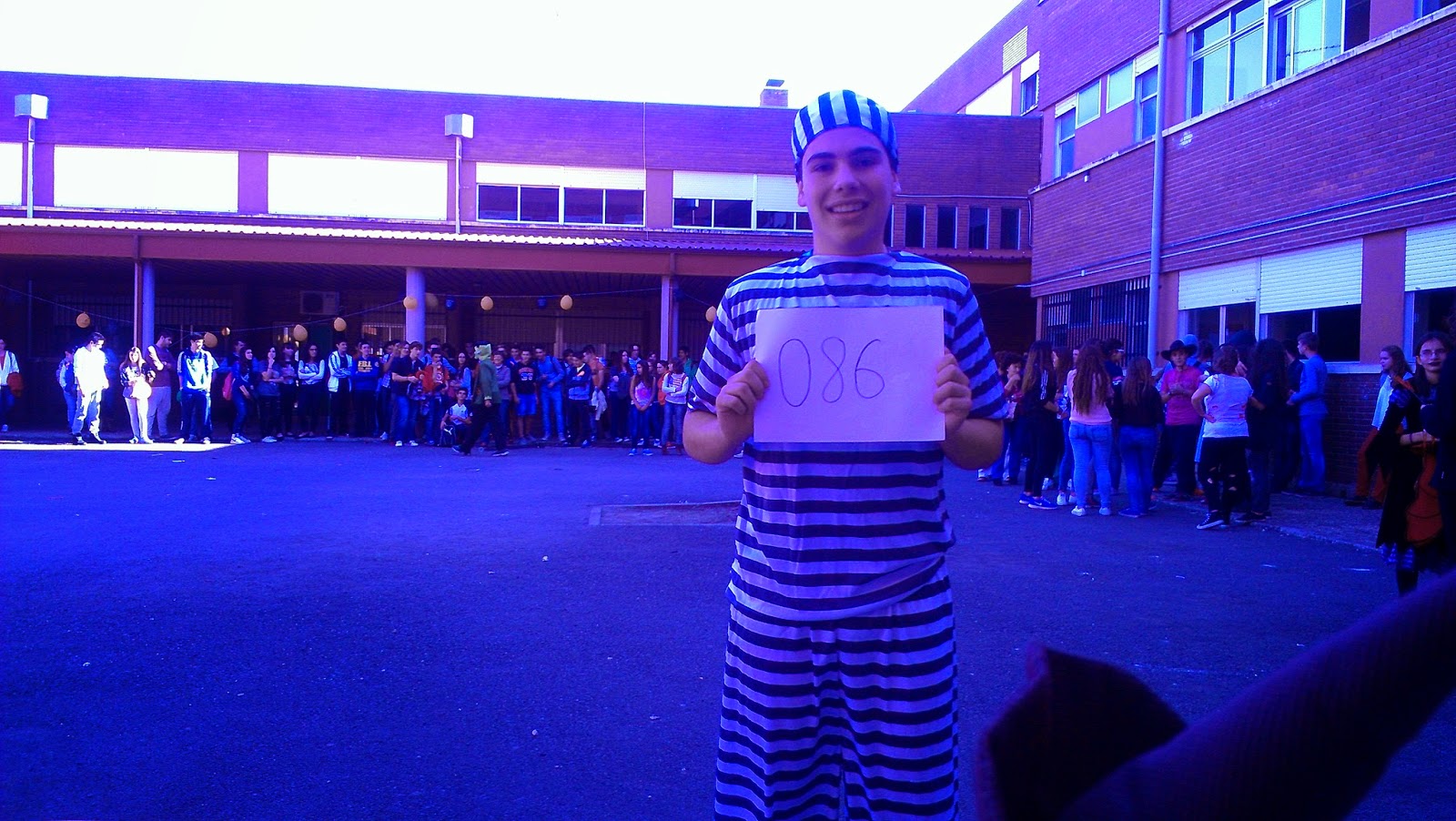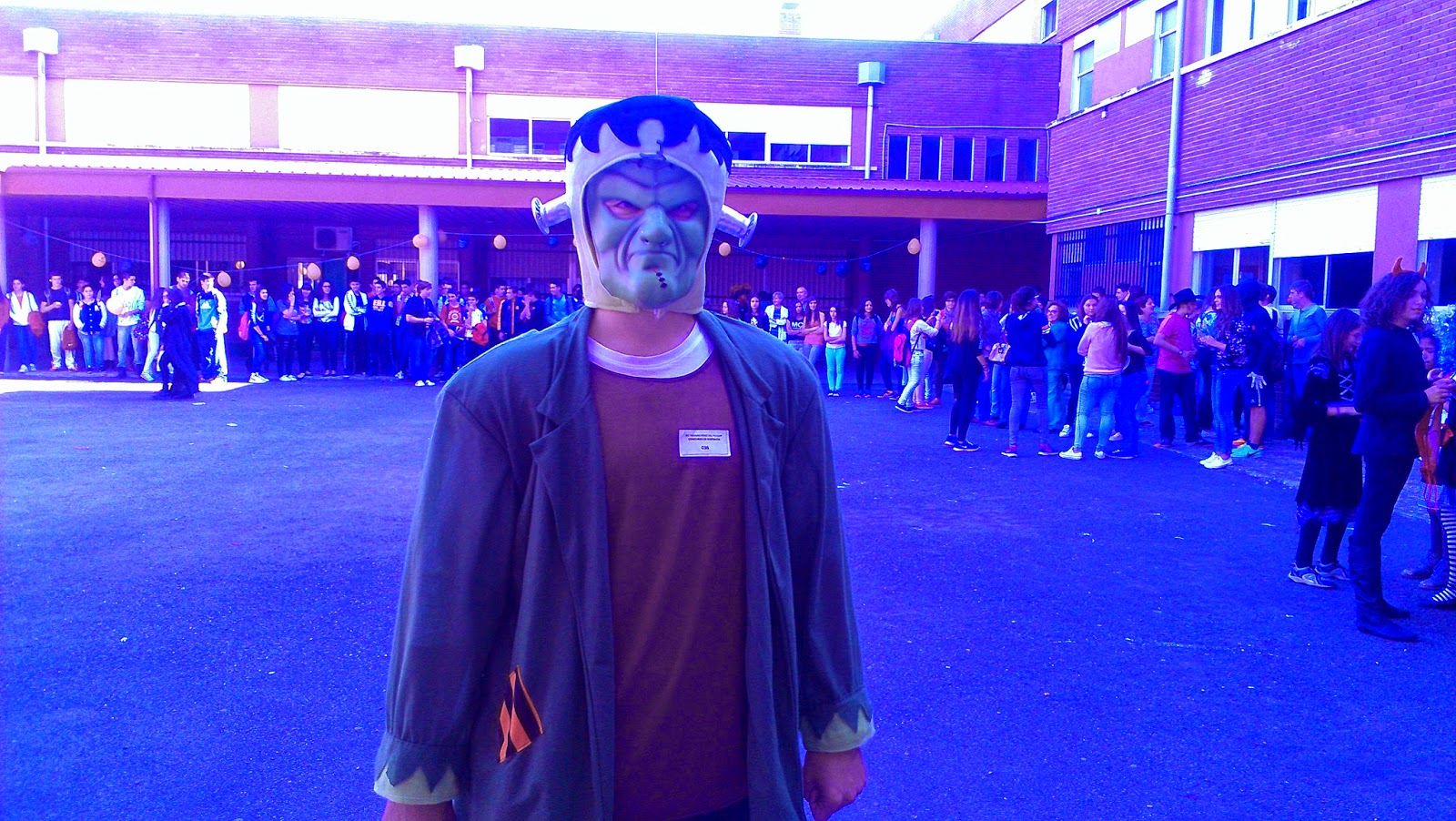 |
| A blank slate can be rather intimidating. |
Category Archives: Teaching ESL
useful auxiliar tip: the 15-minute back pocket exercise
halloween at ies hernan perez de pulgar
field trip to toledo
My second week at school, a group of German students and their teachers arrive for a week-long exchange. Since the Germans hardly speak any Spanish, and the Spanish students at my school speak no German, I’m invited to attend a few of the exchange activities to help with the 1 language that both groups have in common – English.
One of the activities is a day-long field trip to Toledo, a little over an hour away. A chartered bus takes us to the city – which was once the capital of Spain, is the current capital of Castilla La-Mancha, and is a heavily visited tourist destination. One of the teacher chaperones from my school prepared a printout with brief explanations of each of the sites we’d be visiting that day. My charge was to read the descriptions out loud in English to the group of students, then 1 chaperone from each of the respective countries would read the same in German and Spanish. As it turned out, I was the only one who ended up reading aloud to the largely disinterested students. It kinda felt like I was secretly being hazed, but still, it was a small price to pay for being able to explore the city for free.
After an hour or so of playing tour guide, the kids were allowed 3 hours of free time (3 hours!? I couldn’t believe it!) to explore the city on their own. Meanwhile, the other profesand I lounged about – enjoying some amazing tapas and having a leisurely coffee break. Honestly, I would have preferred the 3-hour free time that the students had, as I didn’t get to see all that I wanted to in the city. But I enjoyed having the chance to bond with the other teachers. Also, I thought it was odd that the 2 chaperones from my school were teachers of science and math, as opposed to history or geography, but whatever.
 |
| View of historic Toledo |
 |
| The Tagus River, which surrounds the city on 3 sides |
 |
| A little poem outside La Ermita – the devotional chapel for the Virgin of Toledo |
 |
| Inside La Ermita (Toledo) |
 |
| The students get a chance to ring the bell at the top of La Ermita |
 |
| Altar inside La Ermita (Toledo) |
 |
| Toledo is one of many stops on the Ruta de Don Quijote, a series of sites featured in Cervantes’ seminal work |
 |
| Inside the Puerta de Bisagra Nueva – the main entrance to Toledo |
 |
| Above Puerta Bisagra is the coat of arms of Chales V, which features two eagles, |
 |
| Approaching the Puerta del Sol (Toledo) |
 |
| group shot with the German and Spanish students inside the El Greco musuem |
 |
| El Greco – the famous 16th century painter – was one of Toledo’s most famous residents |
 |
| Tapas with the teachers! |
 |
| The famed ‘migas’ of Castilla La-Mancha. Breadcrumbs sauteed with chorizo and spices, here, with diced melon on top |
 |
| Presa de iberico (sooo good!) with grilled asparagus and an Argentinian style sauce |
 |
| Seen outside of a convent. Ladies drop a hairpin in the hole in front of the picture of the Virgin in hope of finding a mate |
 |
| El Cristo de la Luz – small mosque built in 999 that was later transformed into a Christian oratory |
 |
| Sure! There’s time for a quick pose! |
 |
| Original Roman street stones leading up to the mosque |
 |
| El Cristo de la Luz – as seen from the rear gardens |
 |
| Inside El Cristo de la Luz |
 |
| A cool little performance space / lounge that was originally a small cathedral |
 |
|
|
 |
| Damasquino, or Damescene jewelry – an emblem of Toledo |
 |
| The Toledo Cathedral |
 |
| By this time, all the history was starting to get a bit old (get it?), but the show must go on… |
 |
| A visit to the Sephardic Museum in Toledo – traditional Sephardic garb (women) |
 |
|
|
 |
| Sephardic Museum in Toledo – Sephardic jewelry (yes, please!) |
 |
| Puente de San Martin (Toledo) |
 |
| View of the River Tagus from the Puente de San Martin |
 |
| Sure! There’s time for a quick ussie before leaving Toledo! Me and Pepa (Math) |
a week in the life of an english language auxiliar in spain
Monday
7:45am – Head out the door and down the hill to meet my ride at 7:50. On Monday mornings, I ride to school with Pepe, a biology teacher at IES Vega de Mar in San Pedro de Alcantara. On the 10-minute drive from Marbella, we talk about our weekends and other pleasantries. It’s good practice for both of us. Pepe tries to speak in English, I try to speak in Spanish. Hilarity often ensues.
8:00am – We arrive at school and enter the Sala de Profes (aka, the teacher’s lounge, aka ‘club profe’). After a round of ‘holas’ and ‘buenos’, Pepe and I head straight for our mugs to prep our morning coffee. We take turns treating each other. (Coffee isn’t free for profes. It costs .50€). I sit enjoying my coffee (and if lucky, my take-along breakfast) and listening to the rapid-fire convos between the other profes.
 |
| arriving at school |
8:15am – The bell rings for first period. By now, I am used to the sound of it. Though when I first arrived, I almost had multiple heart attacks, since the bell sounds something like a cross between a fire alarm and an air raid siren. Everyone heads off to their classes. Since I don’t have class this hour, I sit in the lounge and prepare for the day ahead.
9:15am – Time for my first class. History and geography with the 2nd level bilingual students. When I walk into class, several students greet me with a very rehearsed, ‘Hello, Kisha. How are you?” The rest of them are chatting loudly, running around the classroom, or horseplaying with their friends. I have to shout ‘Ready?’ at least 2 or 3 times to get them to settle down. Before getting into today’s lesson, I start off by asking if anybody did anything fun or interesting over the weekend. Many of the students are as eager to share as I am to listen, plus it gives them a chance to practice speaking English in an unstructured way. After everyone has shared, we move on to the lesson. Today, we are reading about daily life in the Middle Ages. I ask for volunteers to read the English handout the profe has selected. Each volunteer first reads a few sentences from the lesson in English, then translates the same into Spanish. We go over unfamiliar vocabulary words as a group, and I answer any questions they may have. The profe, Enrique (aka, Quique), helps out with any Spanish-English translations that I don’t know. Throughout the lesson, I have to stop several times to quiet the class back down or call out a student who is obviously not paying attention.By the end of class, Quique has worked up a sweat and the kids have worked my nerves.
 |
| such adorable little scamps. |
10:15 – First class is over. I head back to the lounge to hang and prep for my next class, which isn’t until 11:35.
11:35 – My second history class. This time with the first-year students. They are quickly becoming my favorite group of the 3 that I work with. They aren’t as boisterous as the 2nd years, but they have way more energy and interest in learning than the 3rd years. However, their level of English is much lower, so it can be a challenge communicating or coming up with in-class activities that they will easily grasp. After the ‘how was your weekend’ chat, we delve into today’s lesson: the government of ancient Rome. Usually we read and translate, but today, I divide the class into several groups. Each must come up with a solution to a problem that the Roman citizenry is facing. They must decide which members of the government they need to work with, and propose their own solution to solve the problem. Not surprisingly, one student asks if they have to give their explanation in Spanish or English. I shake my head, smile, and say, “When I’m here. It’s always English. Vale?” Surprisingly, the students really take to the assignment and they come up with some creative, if not entirely practical solutions.It´s a rare moment of success. I relish in my unquestionable auxiliar awesomeness.
12:35pm – Technically, I’m done for the day. But I have an hour of ‘coordination’, which any of the teachers can use to chat with me about lessons for the coming week or any special projects or activities they want me to prepare for the class. It’s rare that anyone does, but I stick around anyway, just in case.
1:45 – 4:00pm – Workday is officially over! Since it’s Monday, I’m headed to do some grocery shopping. I catch the #4 urbano (aka, local / intracity bus) which stops right outside of the school, to Puerto Banus. From there, I catch the #1 urbano to La Cañada, Marbella’s huge shopping mall. By now, I’m starving, so I stop at McDonald’s in the mall for an after-school snack of patatas deluxe and a beer. Total cost: 2.35€. Inside the mall there is also Alcampo, where I prefer to do my shopping. It’s equivalent to a Super Wal-Mart, so I can get groceries and personal / household items all in one stop. I’ve finally gotten into the habit of bringing along my backpack and a large, reusable shopping tote. Plastic shopping bags are usually not free in any store in Spain – checkout clerks almost always ask: “Bolsa quiere?” (“Want a bag?”) instead of just giving you one – so it literally pays to have your own. Also, the backpack helps me transport heavier items on the bus ride and walk home. I try to stick to my 20-25€ weekly grocery budget, but sometimes I go a bit over if I have to buy things like deodorant or lotion.
 |
| la canada – where i do most of my grocery shopping |
4:00pm – I catch the bus from La Canada back to the main bus station in Marbella, a 7-10 minute walk from my house.
4:30 – Home! Time to put up the groceries and rest a bit before making dinner.
7:30 – Time to unwind for the evening. Maybe I’ll stream a movie online, straighten up my room a bit, hang out in front of the TV with my roommates, or just surf the Internet for a few hours before going to bed. Most likely, I’m still recovering from a long, eventful weekend and I could use the rest.
 |
| relaxing after school with purp, the house kitty. |
Tuesday
8:00am – The sunlight streaming in my window wakes me up. It’s my late day, and I don’t have class until 12:45. I pull the covers over my head and half-sleep for an hour or so more.
10:00 – 11:30am – Even though I tell myself I’m going to accomplish a ton of stuff before heading to school, I manage to fritter away time until it’s almost time to catch the noon bus that will just barely get me to school in time for my 12:45 class.
11:45am – 12:45pm – I make the 7-10 minute walk from my house to the main bus station. I catch the noon bus from Marbella to San Pedro. The bus ride takes about 40 minutes and costs 1.23€.
12:45 – 2:45pm – I have PE class with the 2nd year students. I spend the first half of class explaining 2 different playground games that are commonly played in the US. The students take notes and ask questions before trying the games for themselves. The second half of class I spend in the teacher’s lounge correcting an English presentation about basketball that the teacher has prepared for a different class. Next, it’s off to music class with the first year students. I often get the feeling that the music profe doesn’t exactly know what to do with me in class. Today, is no exception. The students take turns reading from the English textbook (today, it’s about the Baroque period), and I ask them questions about what they just read.
 |
| preparing to teach the kids about four square (the analog one) |
 |
| in music class |
 |
| after-school commute / carpool from san pedro to marbella |
Wednesday
7:45am – Off to meet Pepe!
8:15am – 9:15am – On Wednesdays, I alternate between music and PE classes. Today, it’s PE class with the 3rd year students. I read the presentation on basketball in English, and the profe translates as needed into Spanish. The students make notes about the rules, players, and key vocabulary related to the sport. Apparently they will be tested on this later.
9:15am – 10:15am – English class with my favorite teacher in the school – Mila, the bilingual coordinator. The students’ behavior is markedly different in her class. They are quiet, respectful, and attentive, even though I have to work a little to get their energy level up. Today, we discuss adjectives. I write various adjectives on the board and call on students to guess what they mean. Afterwards, I ask the students to write down 3 adjectives that describe themselves, and we go around sharing all the answers. There are some creative and some downright hilarious responses. This is one of the few classes where I truly get to engage with the students, and I think they enjoy the interaction as much as I do.
10:15 – 11:35am – No class until later, so I lounge in the sala de profes, chatting with some of the teachers, or prepping for tomorrow’s classes.
 |
| The bilingual teachers have a meeting in club Profe. From L to R: Enrique (Quique), Luis, Paco Serrano, Meritxell, Mila. |
11:35am – 12:35pm – PE with the first years. A listening exercise for today. I read a text about juggling, which explains the history of the sport and some different methods, using simple English terms. After I finish the reading I ask the students prepared questions based on the text to assess their level of listening comprehension.
12:35 – 1:35pm – Done for the day! I make the 15-20 minute walk down the street, across a ravine, up a hill, across an overpass, and along the side of the highway to catch my bus. On the ride home, I study my Spanish dictionary, read, or make notes about today’s class.
 |
| after-school commute – crossing the ravine |
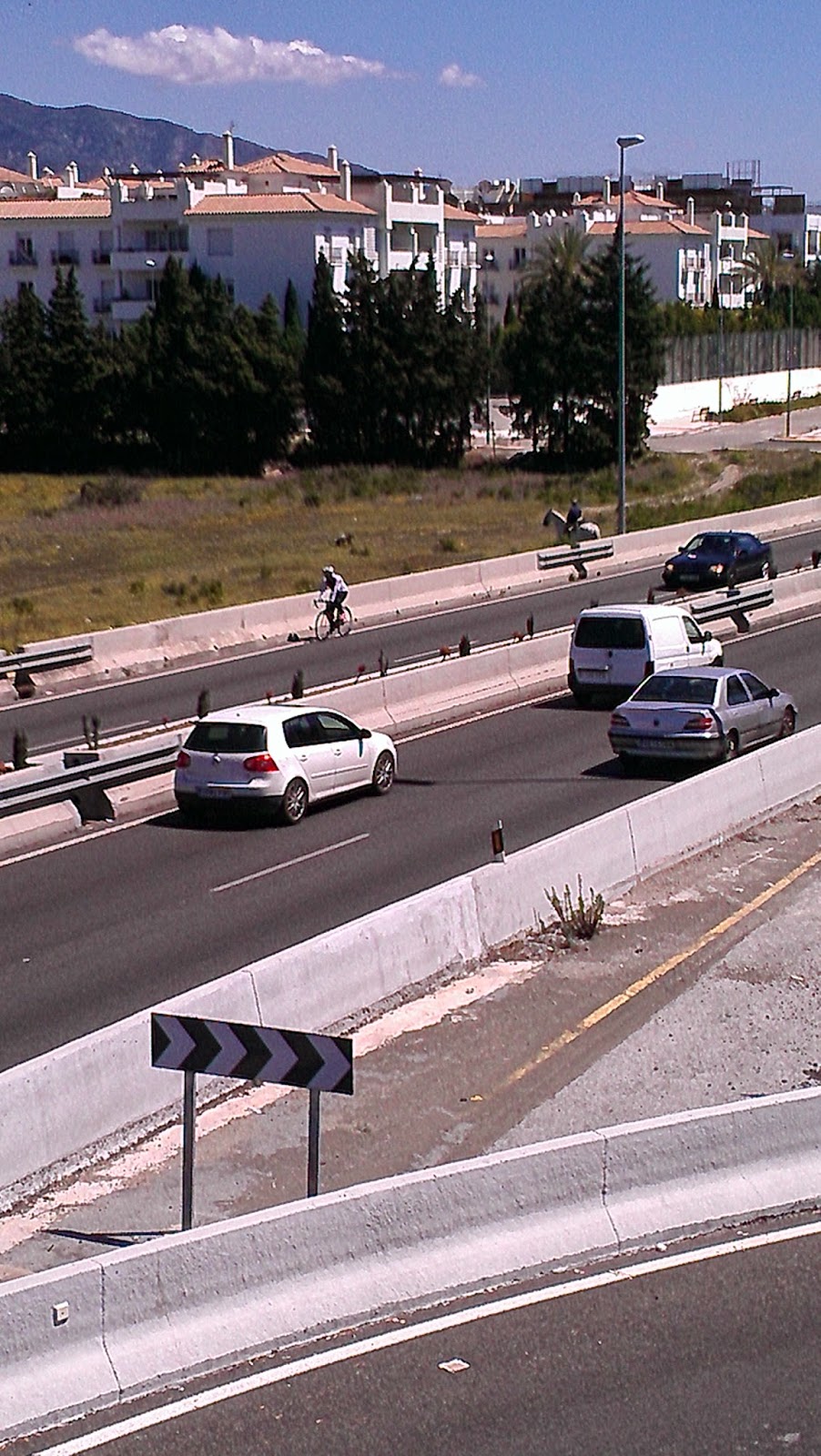 |
| after-school commute – on the overpass |
Thursday
11:30am – It’s Friday! Well, at least for me. It’s my last day of classes for the week. I arrive at the school just in time for my first of 2 math classes.
11:35am – 1:45pm – Back-to-back math classes with the 1st and 2nd year students. I already hate math. So having to ‘teach’ it in English to non-English speakers is not exactly my favorite activity. The profe usually has me work with the students using a prepared handout of exercises. I explain the instructions in English and help the students use English to read the equations and explain their solutions. Most of the time, it goes well, but there are some differences in the way math is done/taught in Spain (commas instead of decimals, methods for division, etc.) that leave me scratching my head. The math profe usually reverts to speaking completely in Spanish (an absolute no-no in my other classes) before the end of the class, so am I often left smiling and pointing like a mute game show host while secretly counting the seconds until class is over. Did I mention that I hate math?
 |
| but when it’s one of the students’ birthday, they do this – which makes math less awful. |
1:45 – 2:45pm – History and geography with the 3rd year students. A cool class since the students are older, and we often get into some pretty deep conversations. Today’s topic: globalization. I lead the students in a brief discussion on how we have all been impacted by globalization. I ask them for examples of music, food, clothing, and TV programs that they like but are not from Spain. Then we do some reading and translation, and finally finish with a video that I found on the topic. The students give a huge round of applause after the video, and I spend the last few minutes of class having them share their opinions on why they think globalization is good or bad. When the bell rings, I get the feeling that all of us are sad that class is over.
Well, maybe not too sad.
class is in session
My first day of class was Monday, January 13. I awoke as excited as I used to be on the first day of school when I was a kid. I had even laid out my clothes the night before, choosing just the right combination of items that I hoped conveyed the message, ‘I’m cool, but I’m here to work, too’.
Like most first days, it was a bit of a blur. I arrived and met the school’s bilingual coordinator, Mila, who, for all intents and purposes is in charge of me. She was extremely excited to see me and I could tell that she was more than a little bit relieved that I was older than the previous two auxiliaries that had been at the school before. The one from the previous year, she told me, was a guy named Curtis from New Orleans. Apparently he was nice enough, but according to Mila, he was more interested in vacationing than actually teaching or putting in work in class. Plus, many of the students and teachers found his English very difficult to understand. I assured Mila that even many Americans found New Orleanian English difficult to understand. The most recent auxiliar, whom I was replacing, had returned to America after only 2 days in town. She had written Mila an email after only 1 day in class explaining that she was very depressed and needed to return to New York immediately to see her therapist. Because of this, the school had been without an English assistant for pretty much the whole school year. It was clear that the bar for performance had been set pretty low, so I figured I wouldn’t have to try too hard to make a good impression here.
One curious note was that apparently, some of the teachers had been expecting a male to show up. They thought the name Kisha sounded like a guy’s name. No idea why.
Some other observations after my first few days on the job:
- The school bell sounds like a cross between a fire alarm and an air raid siren. Near ’bout had a heart attack the first time I heard it! Grabbed my stuff and everything. Then saw everyone else just carrying on like business as usual, so I figured it must be normal.
- A few of the male teachers were kinda lecherous in their introductions. After Mila escorted me into the teacher’s lounge, they were falling over themselves to say hi or try out their English. One even asked me (half-jokingly) which of them I thought was most handsome. Lawd. They’re totally harmless, though. Pretty typical behavior for Spanish men, from what I hear.
 |
| hangin’ in the teacher’s lounge, aka ‘club profe’ |
- Everyone at school has been extremely eager to help out with whatever I ask for. I mentioned to one of the Spanish teachers that I could use some help with my Spanish, and the next day, she presented me with a stack of workbooks for me to take home for as long as I want. After hearing me lament about my long bus ride from my place to school, Mila went around asking everyone if they could let me carpool with them, I’ve already got two folks that I now ride either to or fro with multiple days a week!
 |
| my spanish workbooks |
- The kids here are very boisterous. Not bad, but extremely talkative and undisciplined. I am already trying to set expecations for how I want them to behave, but I can tell it’s going to be an uphill battle.
makes no sense at all
I’m flying to Miami this evening. And I feel like I’m going to throw up. My palms are sweaty. My stomach is in knots. My mind won’t stop racing. I literally feel like a bundle of nerves. I keep telling myself to just breathe. Everything is going to unfold as it should. You’ve done all you can do. The rest is just going through the process and waiting to see how everything turns out. But a few moments after I’ve taken some deep breaths to enhance my calm, my restless mind is back at it again.
Tomorrow I go to the Spanish Consulate just outside of Miami to apply for my visa. The application itself is a daunting process that might make anyone more than a little bit nervous. But my particular visa application experience is even more nerve-wracking since I only have 3 full weeks between my application date and my (alleged) departure date for Spain. For the life of me, I still can’t figure out how this happened, when I started planning for this so early.
Back in early October, I made my original appointment at the Consulate for mid-October. This, however, was before I realized that I would need to gather documentation from everyone and God to take with me for the appointment. It was also before I realized that I would have to travel all the way to South Florida to present said documentation. I decided to reschedule for a later date. A quick look at the Consulate’s calendar revealed that the months of November and December were wide open for appointment slots. “Cool,” I thought. “I’ll just check back in a week or two after I’ve made more progress with my paperwork, and reschedule for late November or early December.” Bad decision. When I did check back about a week and a half later, every date was booked up until mid-December, well after the date that my program coordinator had suggested was advisable in order to ensure the Consulate would have enough time to process my application.
Gulp.
I went ahead and took the next available slot, but over the next couple of weeks, I called the Consulate every other day asking if there were any cancellations or openings for an earlier date. There weren’t.
Gulp.
Ok, then. So this it’s how it’s going to be? Fine. Bring it. I recalled that Dominique and a couple of other program participants had said that it had only taken 2 weeks to receive their visas back from the Consulate, so I held on to that as my one glimmer of hope. 2 weeks. 2 weeks.
Since then, it’s become a sort of mantra for me. As I’ve crossed off every item on the list of documents that I needed to procure or provide, I’ve just kept saying it over and over to myself, as if saying the words will make everything alright. Despite the program coordinator’s advice to hold off on buying my plane ticket to Spain until after the visa appointment, I went ahead and purchased. Those prices weren’t going down any time soon. And besides… 2 weeks.
So here I am, with my overnight bag packed, my packet of documents printed, copied, stapled, and signed; preparing to head to sunny Miami with an invisible cloud of dread and trepidation over my head. I feel like a soldier heading into battle for the first time (kinda like Denzel in that scene from Glory); I feel like how I used to feel just before I had to go to confession, (Forgive me, Father, for being a procrastinator); I feel… like this:
“How in the hell do we get ourselves in these situations?”
Wish me luck.
k
it’s official!
So, for those that don’t already know… it’s official! I will be following in the footsteps of those esteemed ladies of lexis and literature – Ms. Krauss (my middle school English teacher) and Mrs. Reaves (my high school teacher). Starting in January, I, too, will be a teacher of English… in Spain!
I’ll admit I was almost as surprised at the news as everyone else has been so far. When I applied to the CIEE Teach Abroad program back in late September, I remember thinking all of the following, in no particular order:
Wait. Are you sure you wanna do this?
But what about your job?
What about money?
You don’t know the first thing about teaching English.
Is your Spanish really that good?
You? In a classroom? With kids? Real, live… KIDS?
What about somewhere closer to home like Central or South America?
Are you SURE you wanna do this?
But in spite of my initial misgivings, I realized that I had a much bigger decision to make; a decision much more important than how much money or language skills I had. What I had to decide was: would I be the kind of person who actually DID the things she always talked and dreamed of doing, or would I be the type of person who kept putting off a dream or goal until it faded into dim memory or lingering regret?
So… I applied. And then I was accepted. And then I freaked out a little bit. And then after my fellow CAU alum Dominique (aka, La Morena de Andalucia) talked me off the ledge (she’s already in Spain now, and was my inspiration for this lunacy brilliant idea), I started planning for what I think will be one of the biggest adventures of my life.
There’s lots more to share about what’s happened from September to now, but here’s the basics:
The program:
I’ll be participating in the CIEE Teach Abroad Program as an English language assistant. I’ll be working in a secondary school with students from 12-15 years old. I’m not 100% sure of all my duties yet, but I know that I’ll be assisting with a variety of classes, not just English language classes.
Where I’m going:
I’ll be living in southern Spain, a region called Andalusia. During the application process, I was given the option of selecting 3 preferred locations for my school placement. I chose Andalusia because my first-ever Spanish teacher was an American woman who’d lived there for several years. She always told the most charming stories of the area which planted the seed in my mind that one day I’d visit. The other major factor was that Andalusia is characterized by smaller towns, or pueblos, that are not at all like the bustling cities of Barcelona and Madrid. The slower pace of life, the lower cost of living, and the more traditional Spanish lifestyle were all very appealing to me. No surprise there, really. I’m a Southern girl at heart.
My school is located in the province of Malaga, in a town called San Pedro de Alcantara, just west of Marbella. If you’ve heard of Marbella, it’s probably ‘cause it’s a popular resort town known for its picturesque beaches, its posh visitors, and active nightlife. San Pedro isn’t nearly as happening, but it’s still got the beaches and the activity of Marbella just a stone’s throw away. As one of my former colleagues from the UK would say, I’m chuffed. J
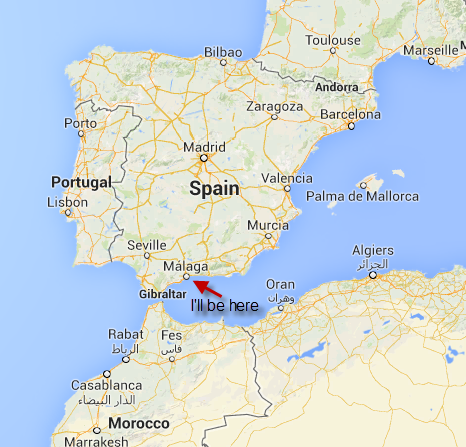
How long I will be in Spain:
I’ll be in Spain for the spring school semester, which starts on January 7 and goes through May. It’s a relatively short stay, but since I’d already missed the deadline for the 8-month program that CIEE also offers, I figured it was good enough.
Where I’ll stay:
For the beginning of my trip, CIEE will provide temporary lodging. After that, though, I’ll have to find my own apartment, which, given my history of sitcom-like life occurrences, will most likely be a ridiculous experience.
Welp, that’s all for now. I’ll be posting more details and stories about my preparation for departure in the coming days and weeks, so stay tuned.
Salud!
k



